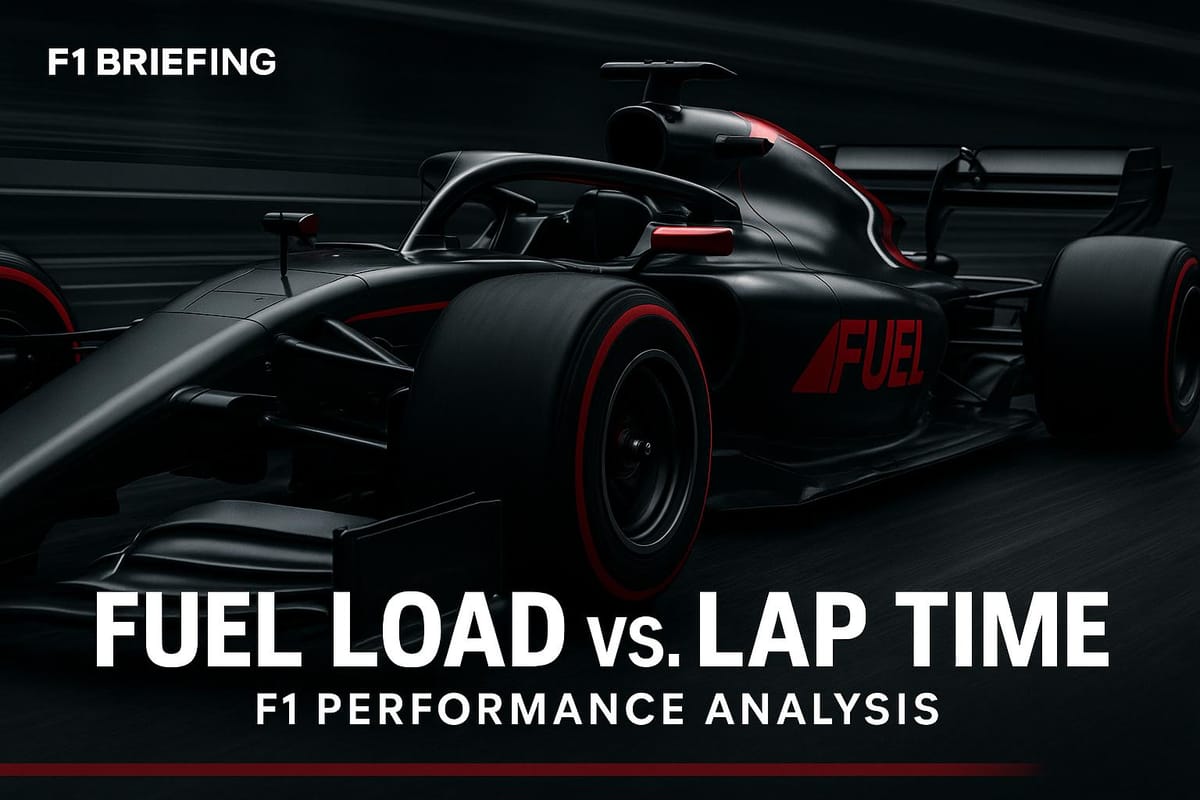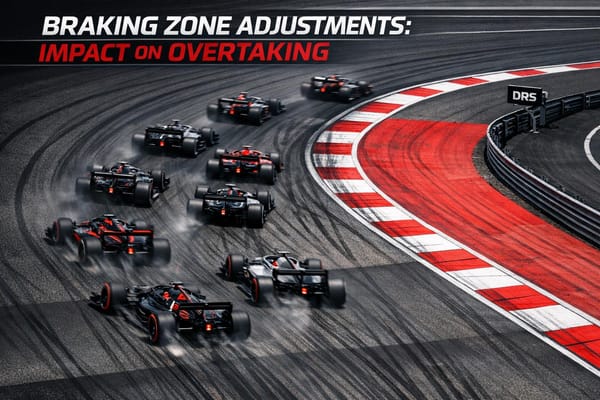Fuel Load vs. Lap Time: F1 Performance Analysis
Fuel load significantly affects lap times and race strategies in Formula 1, balancing speed and endurance is crucial for teams.

In Formula 1, fuel load directly impacts lap times, making it a critical factor in race strategy. Each additional 10 kg (22 lbs) of fuel can slow a car by 0.3–0.4 seconds per lap. Teams carefully balance carrying enough fuel for the race while minimizing weight to maintain speed. Under current regulations, cars can carry up to 110 kg (242 lbs) of fuel, with a flow rate capped at 100 kg/hr, monitored 2,200 times per second.
Key Takeaways:
- Qualifying: Minimal fuel loads (5–10 kg) are used to achieve the fastest lap times, with every kilogram affecting pace.
- Race: Teams often "short-fuel" cars by 5–15 kg to gain an early speed advantage but must carefully manage fuel usage throughout the race.
- Lap Time Impact: A full fuel load slows cars significantly, but as fuel burns off, lap times improve due to reduced weight.
- Modern Tech: Advanced hybrid systems and telemetry allow teams to optimize fuel usage and performance.
Fuel load decisions shape both qualifying and race outcomes, requiring precise planning to balance speed, endurance, and flexibility.
1. Fuel Load in Qualifying
Lap Time Impact
Fuel load plays a massive role in determining lap times during qualifying sessions. Teams typically use minimal fuel loads - around 5–10 kg (11–22 lbs) - to ensure they can complete one fast lap and still have enough fuel to return to the pits. By comparison, in race conditions, cars start with up to 110 kg (242 lbs) of fuel. Testing before the season often reveals that a 50–60 kg (110–132 lbs) difference in fuel can slow a car by 1.5–2 seconds per lap, depending on the circuit. These tests allow teams to assess how much of their performance comes from the car itself versus the advantage of running lighter on fuel.
Strategic Trade-offs
Deciding on fuel loads during qualifying is a precise science. FIA rules require cars to finish qualifying with at least 1 liter of fuel for post-session checks, so teams must carefully plan to avoid penalties. In earlier qualifying rounds like Q1, some teams carry extra fuel to allow for multiple attempts at a faster lap. By Q3, however, the focus shifts to running with just enough fuel for one flying lap. Engineers rely on real-time telemetry to monitor fuel use and make adjustments as needed, but miscalculations can lead to costly grid penalties.
Performance Evolution
Fuel load strategies have come a long way, influenced by changes in regulations and technology. While current car weight rules make fuel load slightly less impactful than in the past, it’s still a critical factor in gaining a competitive edge. Teams use advanced data analysis to estimate rivals’ fuel loads, helping them separate a car’s raw performance from the advantage of running with less fuel.
| Team | Qualifying Fuel Load | Lap Time Impact |
|---|---|---|
| Mercedes | 141 lbs (64 kg) | +0.000% |
| Racing Point | 126 lbs (57 kg) | +0.213% |
| McLaren | 126 lbs (57 kg) | +0.220% |
| Red Bull | 104 lbs (47 kg) | +0.519% |
| Ferrari | 82 lbs (37 kg) | +0.802% |
| Williams | 20 lbs (9 kg) | +1.665% |
| Alfa Romeo | 11 lbs (5 kg) | +1.777% |
Engine management advancements and improved fuel efficiency have allowed teams to refine their strategies further. However, in qualifying, outright speed takes precedence over fuel-saving measures. A better track position gained through a faster lap can often outweigh any benefits of conserving fuel during these sessions.
2. Fuel Load in Race Conditions
Lap Time Impact
In qualifying, teams prioritize speed with minimal fuel loads, but during a race, the challenge shifts to balancing speed and endurance. A full fuel load of 110 kg (242 lbs) significantly slows lap times, with each additional kilogram adding about 0.03 seconds per lap.
As the race unfolds and fuel burns off, the car becomes lighter, resulting in better lap times and improved handling. A heavier car with more fuel compromises braking and cornering, while a lighter car feels more balanced and responsive, particularly during turn-ins. Teams often adjust strategies mid-race to capitalize on the enhanced performance of a lighter car as fuel levels drop.
Strategic Trade-offs
Race strategists juggle the need for immediate speed against fuel efficiency over the long haul. Many teams opt to "short-fuel" their cars, starting with less than the maximum 110 kg. This approach aims to gain an early advantage by improving initial pace and securing track position. However, it demands a carefully calculated fuel strategy for the rest of the race.
Techniques like lift-and-coast, often used during safety car periods or in conjunction with adaptive engine settings, help conserve fuel but come at the cost of slower lap times. Additionally, engine settings are critical for fuel management. Teams can tweak fuel flow rates and adjust hybrid energy deployment to optimize consumption, though these adjustments can directly impact performance. The FIA regulates fuel flow to a maximum of 100 kg per hour, monitored closely by high-frequency sensors, requiring teams to plan power deployment strategically for each stint.
Performance Evolution
Modern hybrid energy recovery systems have revolutionized fuel efficiency, enabling F1 engines to achieve over 50% thermal efficiency - far surpassing the 30% efficiency of standard road car engines.
Advanced simulations allow teams to predict how fuel load, car weight, and lap times interact across different circuits with incredible accuracy. The 110 kg fuel limit, combined with strict monitoring of fuel flow, makes fuel management a crucial factor in race outcomes. Real-time telemetry further enhances this process, enabling teams to dynamically adjust strategies to optimize both performance and fuel usage throughout the race.
How fuel can HUGELY affect F1 car performance
Advantages and Disadvantages
Fuel load strategies in motorsport play a significant role in shaping both qualifying and race performance. Depending on the approach, teams face distinct trade-offs that influence their chances of success. Below, we’ll explore the benefits and challenges of running with light versus heavy fuel loads.
Light fuel loads shine in qualifying sessions. By minimizing fuel weight, teams can achieve peak performance. For instance, Alfa Romeo’s 5 kg (11 lbs) fuel run during the 2020 Bahrain test showcased how light loads can deliver optimal lap times. However, this strategy has its drawbacks when it comes to race day. Starting with minimal fuel often forces teams to adopt conservation techniques like lift-and-coast, which can compromise overall race pace. Even a small miscalculation in fuel usage could lead to penalties or, worse, a forced retirement from the race.
On the other hand, heavier fuel loads offer a different set of advantages, particularly during the race. While the added weight slows down initial laps - Mercedes, for example, recorded their best test laps with around 64 kg of fuel compared to lighter setups - it provides greater strategic flexibility. Teams have more room to adapt to unexpected events like extended safety car periods and don’t need to rely as heavily on fuel-saving measures. This allows for a more consistent pace throughout the race, although it comes at the cost of early-lap performance, which can be crucial on tracks where overtaking is difficult.
| Strategy | Lap Time Impact | Strategic Flexibility | Risk Level | Best Application |
|---|---|---|---|---|
| Light Fuel (Qualifying) | Fastest possible times | Low – single-lap focus | Medium – limited race options | Securing grid position |
| Light Fuel (Race) | Strong early pace | Low – requires conservation | High – fuel shortage risk | Gaining early track position |
| Heavy Fuel (Race) | Slower initial laps | High – multiple options | Low – safety buffer | Handling unpredictable conditions |
The strategic importance of these decisions is heightened by modern hybrid systems, which achieve thermal efficiencies exceeding 50%. Since the ban on in-race refueling in 2010, teams must commit to their chosen fuel strategy for the entire event, making precise calculations even more vital. In this context, the balance between fuel load, performance, and flexibility becomes a defining factor in race outcomes.
Conclusion
In Formula 1, every 10 kilograms of fuel adds roughly 0.3 to 0.4 seconds to a lap time, which forces teams to carefully weigh the trade-off between early-race speed and the risks tied to fuel consumption. With modern engines and the strict 110-kilogram fuel limit, this balancing act has become even more critical in shaping race strategies.
A noticeable drop in a driver's pace midway through the race might not always point to tire wear or mechanical problems - it could indicate a shift to fuel-saving mode. When teams opt to short-fuel, they’re making a calculated bet that the advantage of an early lead will outweigh the challenges of conserving fuel later in the race.
But it’s not just about the numbers. Teams also factor in safety car probabilities, tire wear, and overtaking opportunities when deciding how much fuel to load. For example, trimming just 2 kilograms of fuel can deliver a tangible improvement in lap times, but only if the team can carefully manage consumption across the entire race.
For more detailed breakdowns of these strategies, F1 Briefing provides expert analysis on race tactics, technical developments, and performance trends. Their insights help unravel the intricate connections between fuel management, lap times, and the outcomes that often decide championships.
FAQs
How do F1 teams decide the best fuel load for a race?
F1 teams put a lot of thought into determining the perfect fuel load, striking a balance between speed and efficiency - a critical part of their race strategy. Using advanced simulations, they predict fuel consumption by factoring in the track's layout, weather conditions, and the car's performance.
The goal? Carry just enough fuel to finish the race. Less fuel means a lighter car and faster lap times, but they can't afford to run out before the checkered flag. This fine-tuned approach is what keeps teams competitive from start to finish.
What are the pros and cons of starting a Formula 1 race with less fuel?
Starting a Formula 1 race with less fuel in the tank can offer some clear perks. For starters, faster acceleration and improved handling become immediate benefits. A lighter car is more agile, making it easier to navigate corners and execute overtakes, which can translate into faster lap times early on.
But there’s a trade-off. Carrying less fuel means you’ll likely need to pit sooner, which could cost valuable time and even track position. And if a team misjudges the fuel calculations, there’s the looming risk of running out before crossing the finish line. Striking the right balance is crucial - teams need to weigh the performance boost against the potential strategic setbacks.
How do hybrid systems and telemetry influence fuel management in F1 races?
Modern Formula 1 fuel management has been revolutionized by hybrid systems and cutting-edge telemetry. Telemetry provides teams with real-time insights into fuel consumption, enabling them to adjust and optimize fuel usage on the fly during a race.
Hybrid systems add another layer of efficiency by recovering and deploying energy smartly. This reduces fuel dependence while ensuring cars maintain competitive speeds. By combining these technologies, teams can strike the perfect balance between performance and fuel efficiency, adjusting their strategies as race conditions evolve.




